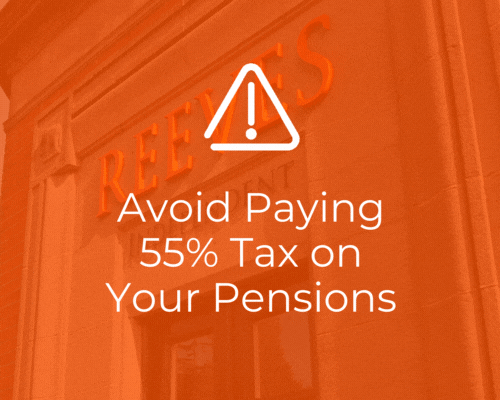Pension schemes enjoy some generous tax benefits - such as income tax relief payments, as well as tax-free growth thereafter.

These benefits can turbo-charge your retirement savings and allow you to make provisions for your retirement.
It also means that the taxman loses out on potential revenues so, even though he gives these reliefs, there are limits to his generosity. That limit comes in the form of a lifetime pension allowance, which this year stands at £1,055,000. If you pay more than that into your pension, you’ll be taxed on any excess. The tax rates are 25% if it’s withdrawn as income, or as much as 55% if it’s withdrawn as a cash lump-sum. This charge is imposed at the point you start withdrawing funds from the pension.
One client, Tom Garner, had built up a pension fund of £1.5m. He came to us for advice on what he should do in the coming years: should he continue to pay surplus cash into his pension? We wouldn't advise this, because he had already exceeded his lifetime allowance. Instead, we advised Tom to add to his retirement planning through other means.
Tom's next question was: should he crystallise the whole fund now, as he is over the age of 55, paying the tax charge so that the remainder could be taken in the form of a drawdown pension?
We recommended another option: to adopt a phased crystallisation strategy so that each year Tom only crystallises enough of his pension to give him his required annual income of £50,000.
In the first year, he uses £12,500 of his income tax allowance, leaving Tom to find a balance of £37,500. So, Tom crystallises £150,000 - this will enable him to take 25% tax-free. This is only just over 14% of his lifetime allowance and, because the lifetime allowance and personal income tax allowance increase every year in line with inflation, this percentage progressively reduces. This means Tom can go for over eight years without paying any tax, at the point at which he has reached his full lifetime allowance. All this time, he is keeping money in his pension pot which can continue to grow.
If he had taken the first option and crystallised the whole pension now, he would have been taxed at 55% on the difference between his £1.5m and the £1,055,000 lifetime allowance, which would have landed him with a tax bill of about £245,000.
It’s a pity Tom didn’t come to Reeves three years before as we could have saved him even more. To provide some compensation to those whose pensions were greater than the limit when it was introduced in 2016, two types of protection were introduced: Individual Protection and Fixed Protection.
You could apply for Individual Protection if your savings were worth more than £1m on April 5 2016 and get a personal lifetime allowance equal to the value of your pension savings at that date, up to a limit of £1.25m.
Or, you could apply for the Fixed Protection if you, or your employer, hadn’t added to your pension since April 5 2016, or if you opted out of any workplace schemes before that date. This would also give a protected lifetime allowance of £1.25m.
Tom could have fixed his lifetime allowance at £1.25m, but he continued contributing to his pension, which meant that he was ineligible.
__________________________________________________________________
The articles are for information only and should not be construed as advice or a recommendation. The investment strategies mentioned are examples only and may not be suitable for your particular: circumstances, tax position or objectives. Please seek independent financial advice before taking any action.
Names have been changed to protect identity.
No advice should be conferred from the articles. No action should be taken without independent professional financial advice as any actions on your pension may be irrevocable and have a big impact on your income in retiremen


